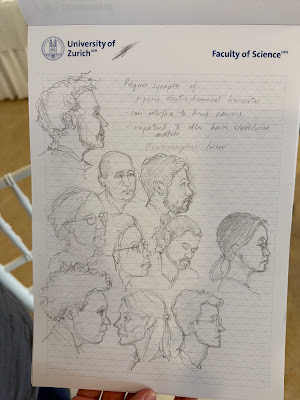Day 10 - BMIs with neuromorphic substrates: Francesca Santoro, Elisa Donati, Jean-Jacques Slotine
Francesca Santoro: Engineering Organic Neuromorphics
What if the materials we use to interface with the brain were as soft, adaptive, and chemically dynamic as the brain itself?
Francesca's work in organic bioelectronics proposes exactly that. She started by introducing the term Neurohybrids and by setting the stage with a key observation about the biological brain: its function is deeply shaped by its topology (connectivity), mechanics (structure and material properties), and plasticity (adaptability). Unlike traditional artificial neural networks (ANNs), which are largely implemented in software or rigid CMOS hardware, biological systems operate in soft, aqueous, ion-rich environments. So, how do we bridge that gap?
She introduced organic mixed ionic-electronic conductors (OMIECs), which are materials that can conduct both electrons and ions, operate at low voltages, and remain functional in liquid, biocompatible environments. Unlike rigid CMOS, these materials are flexible, stretchable, and even biodegradable, making them uniquely suited for long-term integration with brain tissue. A key example of organic materials mentioned is OLEDs, already common in flexible screens, operate using similar organic principles.

The OECT: An Organic Synapse?
At the heart of her talk was the organic electrochemical transistor (OECT), which is a soft, ion-driven device capable of mimicking short-term plasticity (STP) and, under certain conditions, long-term plasticity (LTP). These devices can be tuned to “remember” activity patterns by leveraging mechanisms such as dopamine-triggered oxidation, much like biological synapses!
• When a train of voltage pulses is applied, ions diffuse into the polymer, modifying its conductivity.
• This behavior can be reversible (for short-term plasticity, STP) or irreversible (for long-term plasticity, LTP), depending on timing, amplitude, and chemistry.
• These devices are “slow” (on the order of milliseconds or seconds), but they match biological time constants, making them excellent candidates for bio-inspired computing.
“Sometimes,” Santoro noted “these are bad transistors, but that’s exactly what makes them good synapses.” Their imperfections, like residual memory from ion diffusion, mimic how biological systems forget and adapt. This convergence of bio-mimicry and electronics is more than just an engineering trick. It opens a door to two-way communication between neurons and machines, toward a future of biocompatible implants, closed-loop neuromodulation, and hybrid systems.
How Do They Work? A Quick Analogy
Imagine applying a small voltage pulse (like an action potential). Ions from an electrolyte move into the organic channel. This changes the channel’s conductivity, like neurotransmitters modulating a real synapse.
• If the next input comes quickly, residual ions affect the response --> this is STP.
• If the stimulus is strong enough, it triggers molecular changes (like oxidation via dopamine), and the device remembers the event --> this is LTP.
Santoro showed how using dopamine (a real neurotransmitter) allows these devices to encode memory chemically. The number of protons released during dopamine oxidation modulates the device’s conductivity, emulating how real synapses strengthen with more neurotransmitter activity.
The Big Vision: Biohybrid Systems
The long-term vision is clear: create materials that don’t just connect to neurons, but communicate with them. She discussed several key research directions:
• Creating closed-loop neuromorphic circuits that adapt based on feedback.
• Embedding miniaturized organic systems into implants, possibly for drug delivery.
• Designing 3D, biomimetic architectures that resemble real neurons, not just functionally, but structurally (!), so that real neurons can form synaptic-like contacts with devices. She emphasized that these materials can be made to look and feel like biological tissue, increasing integration and functionality. This includes surface textures that encourage neurons to grow and form structured, functional interfaces with the artificial system. “We don’t have to be limited to 2D,” she noted. “We can design materials that neurons recognize, that feel like home.”
Some Takeaways
• OMIECs and OECTs are enabling new types of neuromorphic devices that are soft, low-power, and bio-friendly.
• These devices mimic synaptic plasticity via ion dynamics, both reversible (STP) and irreversible (LTP).
• Real neurochemicals like dopamine can be used to encode memory in hardware.
• The future of bioelectronics involves not just reading from the brain, but embedding systems that interact, adapt, and even grow with brain tissue.
This talk set the tone for the rest of the day. Neuromorphic substrates aren’t just about mimicking the brain in silicon, they are about making brain-machine communication possible in entirely new ways :)
Elisa Donati: Building a Neuromorphic Twin
What if we could build a digital twin of the brain, not a simulation, but a living, spiking network that runs in real time and restores lost function?
In her talk, Elisa introduced the concept of the "Neuromorphic Twin", an innovative framework that goes beyond conventional modeling towards embodied neural restoration.
What is a Neuromorphic Twin?
Most of us have heard of digital twins in engineering; these are exact digital replicas of real-world systems used to monitor, simulate, and optimize performance. But when we move into neuroscience, the idea becomes more profound. Can we create a real-time, hardware-embedded twin of a neural circuit that mimics its function, dynamics, and behavior? In this work, the idea is brought to life with neuromorphic hardware, specifically FPGAs running Hodgkin-Huxley neuron models. The twin is designed to replicate the behavior of a specific cortical region in rats, the Rostral Forelimb Area (RFA), which is involved in motor control. After a stroke, this area’s communication with the sensorimotor cortex (S1) is disrupted. The goal is to use the neuromorphic twin to restore that communication and behavior.
From Recording to Remapping: How?
1. Record from RFA before or after stroke.
2. Extract neural statistics: mean firing rate, burst duration, activity patterns.
3. Create a neuromorphic twin: a spiking network on an FPGA mimicking the RFA’s behavior.
4. Use PCA to extract a latent space, a reduced-dimensional map of RFA activity over time.
5. Stimulate S1 based on the twin’s dynamics, to remap activity to restore movement.
The result? In rats, sensorimotor behaviors were partially restored, even with just one well-matched artificial neuron. And critically, this wasn’t just a hard-coded pattern, it was a dynamic, adaptive interaction between the chip and the brain.
Why FPGAs?
FPGAs allow fast, flexible reconfiguration of large neuron populations (1024 in this case), supporting real-time feedback. This is crucial when the goal is to intervene in active sensorimotor loops, where milliseconds matter. However, there’s a tradeoff: complexity and computational cost. Real-time emulation of even 1000 coupled Hodgkin-Huxley neurons is non-trivial. That’s why Elisa's team also looked at dimensionality reduction, focusing on just a few principal components (often 3) of the RFA’s activity to guide stimulation of S1.
From Rats to Humans: The Bottom-Up Path
Donati also shared a related bottom-up study in collaboration with clinical researchers. In tetraplegic patients, electrodes implanted in S1 (sensory cortex) are used to stimulate sensory perception. But a common issue arises: the adaptation. After a few seconds, patients stop feeling the stimulus, even when firing rates remain high. To understand this better, they modeled layer 4 of S1, incorporating:
• Pyramidal cells - excitatory neurons
• PV (Parvalbumin) - inhibitory neurons
• SST (Somatostatin) - inhibitory neurons
They built a simple spiking circuit with realistic adaptation properties and showed that at different stimulation frequencies (50, 100, 300 Hz), pyramidal cell firing adapted just like human perception does. This was a powerful demonstration that even minimal neuromorphic models can replicate human sensory phenomena, which is a major validation of the neuromorphic twin as a concept.
Closed Loop - Real Time - Real Impact?
The next goal? To close the loop using the twin, not just to reproduce activity, but to modify stimulation in real time, adapting to the brain’s feedback. But current tools are limited: full closed-loop control at this scale is still computationally very intense. Still, the twin offers a powerful advantage over pure simulation:
• It operates in real time.
• It embeds physical computing constraints, just like the brain.
• It enables exploration of emergent dynamics within biologically grounded models.
“You start with emulation,” Elisa said, “and only then go back to simulation, now with a better understanding of what matters in solving the real problem, as you are forced to deal with the physical constraints of the system.”
Some Takeaways
• Neuromorphic Twins are the concept of real-time spiking models that replicate specific brain regions, not just in structure but in function.
• They could support neuroprosthetics and brain restoration, e.g., in post-stroke motor control.
• Minimal spiking networks can reproduce complex sensory adaptation seen in humans.
Jean-Jacques Slotine: What Deep Learning Still Doesn’t Understand About the Brain (and Vice Versa?)
The morning discussions ended with a deeply reflective talk by Jean-Jacques Slotine, who posed a powerful question:
“Everyone says AI is inspired by neuroscience, but can you name one major discovery from neuroscience in the last 50 years that made it into AI?”
Jean-Jacques reminded us that while machine learning has made incredible strides, its connection to real biological computation is often superficial and/or outdated. Many of AI’s foundational ideas, from Hebbian learning to local node computation, are decades old. Meanwhile, neuroscience has uncovered a rich world of complexity, including the roles of glial cells, astrocyte dynamics, and non-synaptic modulation, most of which is still absent in mainstream AI.
Astrocytes: The Silent Giants of Computation
Jean-Jacques began by highlighting astrocytes, glial cells that often outnumber neurons and can each connect to up to 100,000 synapses. These are not just passive support cells. They regulate neurotransmitter levels, shape synaptic plasticity, and potentially enable new forms of computation. If evolution kept astrocytes around, it probably found them computationally useful. He suggested that modeling astrocytic processes could offer AI novel mechanisms, especially for sparse connectivity, context modulation, and attention, as seen in transformer architectures. In fact, he demonstrated how a simplified astrocyte-modulated model can mathematically implement something equivalent to attention (seen in transformers). In his words: “Astrocyte-inspired dynamics may offer a biologically grounded alternative to the transformers' "magic".”
Why Does Deep Learning Work? A Dynamical Systems Perspective
“Why does overparameterized gradient descent actually work so well?”
Using tools from nonlinear dynamics, he described how the loss landscape in deep networks can contain multiple equilibria (solutions), and how gradient descent often finds flat valleys of global minima, regions in which many solutions generalize well.
But this only works under one critical condition.
Some Takeaways
-
Astrocytes could provide a biological analog for mechanisms like attention and context-sensitive learning.
-
Gradient descent in high dimensions works in part because of contractive geometry: smooth, connected solution paths enabled by overparameterization.
-
Incorporating ideas from dynamical systems and biology could help reveal why neural networks generalize and guide us toward more robust and efficient AI systems.
Proof that scientists can be great artists ;) 🖌
Notes and sketches by Barbara Webb during morning discussions (🤩 wow)
Notes and sketches by Stan Kerstjens during this morning discussion (so cool🧠)
.HEIC)
















Two comments:
ReplyDelete(1) Francesca Santoro's ideas sound brilliant - a much better way of doing neuron/electronic bidirectional communication that large arrays of tiny electrodes.
(2) J-J Slotin's question "“Everyone says AI is inspired by neuroscience, but can you name one major discovery from neuroscience in the last 50 years that made it into AI?”": look into the details of neocortical pyramidal neurons which have both basal and apical dendrites and two sites of integration with modulation taking place by the apical on the basal. See Adeel Ahsan https://arxiv.org/abs/2505.06257 (paper now submitted to NIPS 20250, based on decades of work by Bill Phillips and neuroscientists at HBP and elsewhere, see Phillips, W. A. et al. Cellular psychology: relating cognition to context-sensitive pyramidal cells. Trends Cogn. Sci. (2024) doi:10.1016/j.tics.2024.09.002.
NIPS 2025, not NIPS20250!
Delete